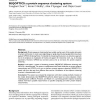67 search results - page 10 / 14 » Grammar-based distance in progressive multiple sequence alig... |
BMCBI
2010
13 years 7 months ago
2010
Background: Conservation and variation scores are used when evaluating sites in a multiple sequence alignment, in order to identify residues critical for structure or function. A ...
BMCBI
2008
13 years 7 months ago
2008
Background: Due to recent progress in genome sequencing, more and more data for phylogenetic reconstruction based on rearrangement distances between genomes become available. Howe...
CVPR
2009
IEEE
15 years 2 months ago
2009
IEEE
The goal of this work is to automatically learn a large
number of British Sign Language (BSL) signs from TV
broadcasts. We achieve this by using the supervisory information
avai...
BMCBI
2006
13 years 7 months ago
2006
Background: Protein sequence clustering has been widely used as a part of the analysis of protein structure and function. In most cases single linkage or graph-based clustering al...
BMCBI
2010
13 years 7 months ago
2010
Background: Accurate classification into genotypes is critical in understanding evolution of divergent viruses. Here we report a new approach, MuLDAS, which classifies a query seq...

